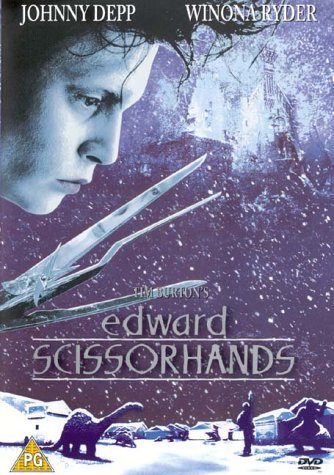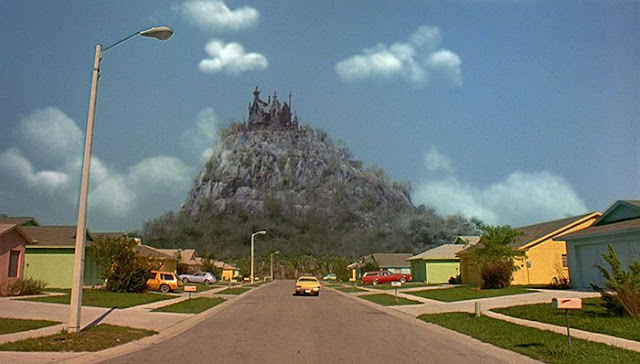Edward Scissorhands (1990) - Film Review.
From the creative mind that is Tim Burton comes Edward Scissorhands (1990); directed by
Burton and co-written with Caroline Thompson as screenplay writer, together
they create a suburban world full of prejudice and curiosity as well as create
a visual full of “special effects and
visual tricks to create sights that have never been seen before.” (Ebert, 1990).
Within the feature Burton appears to focus mainly on exaggerating suburban life
in a small town ranging from the 1950’s to the 90’s and looks at various
stereotypes and common archetypal themes that take place in a skewed and
distorted society. (Fig 1, see below)
 |
| Fig 1. Edward Scissorhands (1990) [Film Poster, Advertisement.] |
Within the feature film, Burton explores the theme of
suburbanisation heavily through the mise-en-scene of the street layout,
depicting very uniform houses that vary in pastel colours to show individuality
of the occupants living there (Fig 2, see below). Through doing so it creates
this compact housing estate designed specifically for domestic life where the
occupants would try to personalize their homes through decoration - as seen
with the topiary sculptures created by Edward - even the layout and structure
of the houses are the same as the neighbours, creating this sense of suburban
conformity within the sets. This then relating strongly to suburban culture at
the time, as in the United States suburban life was on the rise from the 1950’s
through to the 90’s as suggested by Alex Arabia;
“Traces of 1950s post-war
suburban American society can be seen in the uniform, single-story modern home
architecture, the neighbors’ matching old station-wagons, and Burton’s
now-signature bird’s eye shots of every car pulling out of its own driveway in
unison, representing the collective automation that suburban society created.” (Arabian, 2017).
With this in mind it creates this exaggerated world of
routine and conventionality as everyone is doing the same thing at the same
time in ‘’unison’, similarly implying they are part of a machine as suggested
by “collective automation” which implies that these everyday actions become
routine as an automatic response to act upon.
 |
| Fig 2. Peg drives up to gothic mansion [Film Still] |
Edward Scissorhands
(1990) also plays thorough attention to stereotypes that were posed during the
late 1900’s, this seen with the Edwards character which plays on the Gothic
trope of wearing dark colours, having pale skin, darkened eyes and the use of
sliver metal buckles laced throughout the costume (Fig 3, see below). This then
creating a seemingly threatening character with the addition of scissors for
hands, which then would then lead to the pretence that Edward is a
dangerous/violent character; when in fact the audience knows he is far from disruptive
and is shyer and more conserved in his actions towards others. This forming a
prejudice view on those who dress in darker colours to be more violent and
mysterious, compared to those who wear brighter, bold colours and appear more
approachable/open. Another add on example of this would be when Jim breaks into
his own house with Kim and their friends dressed in all black clothing, this
would then relate to a common archetype of robbers/criminals wearing all black
clothing (Fig 4, see below). Which at the time this was set crime was just leveling
out from the spike in illegal activity from the 1980’s. Other stereotypes
within the feature include the classic house wife scenario where the women stay
home and tend to the house and “cloyingly nosy nature of the residents”
(Arabian, 2017), this seen in the film when the men come home from work and the
women are gossiping on the corner about the new arrival in town and then rush
home to sort out the dinner.
 |
| Fig 3. Concept sketch of Edward Scissorhands/Johnny Depp in the film Edward Scissorhands [Photograph, Sketch]. |
 |
| Fig 4. Jim threatening Edward [Film Still] |
Burton; although subtle, also introduces psychological
problems that rise from living in a suburb and shows the outcomes of how living
in isolation can affect a person’s outlook on life. For example the suburban
people become excited at the prospect of a new neighbour, but their views
quickly become twisted after one wrong action carried out by Edward and the rumours
spread by Joyce after he declines her sexual advances. This then poses the idea
that Edward is not equipped with the social skills required to interact with
people at the level they are expecting of him due to his limited to no contact
with the outside world. As stated by Marc Lee “palpably personal feel: it is
told gently, subtly and with infinite sympathy for an outsider who charms the
locals but then inadvertently arouses their baser instincts.”(Lee, 2014). This implying
that audience may feel “sympathy” for Edward since the narrative is predominantly
being told from his view and may even feel singled out as the suburban
community takes it upon themselves to belittle him due to his lack of social experiences.
Alternatively this may even reflect the director’s inner emotions and how he may
have felt like an “outsider” in his own community and Edward is a projection of
his inner isolated self.
Overall Edward Scissorhands
(1990) is a film of society’s inner psyche in terms of visually showing prejudice
and stereotypes alongside exampling people who are of a different mentalities
within a community. Other films of Burton also explore this concept of
isolation and prejudices as seen with Sweeny
Todd: The Demon Barber of Fleet Street (2007) where customers come to Todd
for a shave, but not realizing how close a shave that is when it’s their life on
the line; alongside Todd being in the false frame of mind that he has lost
everything and becomes withdrawn and isolates himself with one obsession of
killing the Judge Turpin for pulling his family apart. Similarly seen with Burton’s
more recent film Miss Peregrine’s Home
for Peculiar Children (2016) where it deals with the idea of children never
getting older and are confined to a repeating loop living the same day over
again; much like how suburbanites would repeat the same tasks each day
conforming to this idea of normalization.
Bibliography:
Arabian, A. (2017) EDWARD SCISSORHANDS: Tim Burton's
Timeless Masterpiece. At: https://www.filminquiry.com/edward-scissorhands-1990-review/
(Accessed 12/11/2019) In-text citation: (Arabian, 2017).
Ebert, R. (1990) Edward Scissorhands movie review (1990)
| Roger Ebert. At: https://www.rogerebert.com/reviews/edward-scissorhands-1990
(Accessed 12/11/2019) In-text citation: (Ebert, 1990).
Lee, M. (2014) Edward Scissorhands, review: 'a true
fairytale' – Telegraph. At: https://www.telegraph.co.uk/culture/film/filmreviews/11298442/Edward-Scissorhands-review-a-true-fairytale.html
(Accessed 12/11/2019) In-text citation: (Lee, 2014).
Illustration list:
Fig 1. Edward Scissorhands (1990) [Film Poster,
Advertisement.] At: https://www.imdb.com/title/tt0099487/mediaviewer/rm3599408640
Fig 2. Peg drives
up to gothic mansion [Film Still] In: Edward Scissorhands (1990). At: https://www.imdb.com/title/tt0099487/mediaviewer/rm18944256
Fig 3. Concept sketch of Edward Scissorhands/Johnny Depp
in the film Edward Scissorhands [Photograph, Sketch]. At: https://howlsmovingsingalongblogandthegiantpeach.wordpress.com/2011/10/17/burtons-concept-art-and-creative-process
Fig 4. Jim threatening Edward [Film Still] In: Edward
Scissorhands (1990). At: https://www.imdb.com/title/tt0099487/mediaviewer/rm2975027968



Comments
Post a Comment